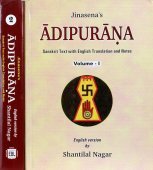Fifth veda: 1 definition
Introduction:
Fifth veda means something in Hinduism, Sanskrit. If you want to know the exact meaning, history, etymology or English translation of this term then check out the descriptions on this page. Add your comment or reference to a book if you want to contribute to this summary article.
In Hinduism
Pancaratra (worship of Nārāyaṇa)
Source: archive.org: Catalogue of Pancaratra Agama TextsThe “Fifth Veda” refers to a certain knowledge which leads to Mokṣa, as discussed in chapter 1 of the Śeṣasaṃhitā: a Pāñcarātra text comprising 2800 Sanskrit verses narrated by Śeṣa (=Ananta) to Nārada and dealing primarily with the use of the appropriate mantras for various occasions such as jayantī celebrations.—[Cf. chapter 1]: Śeṣa promises to tell Nārada what Nārāyaṇa originally gave to him in the form of the “Fifth Veda” which alone leads to mokṣa, to Hari and to everything that is desired (3-4). One must do worship to the Lord only in the way prescribed in the Pāñcarātra, using Vedic mantras. Those who worship Viṣṇu by observance of the five kāla-periods will attain the four aims of life and, in the end, enjoy perfect bliss. For mumukṣus, prapannas and paramaikāntins, this way outlined is the only way (5-8).

Pancaratra (पाञ्चरात्र, pāñcarātra) represents a tradition of Hinduism where Narayana is revered and worshipped. Closeley related to Vaishnavism, the Pancaratra literature includes various Agamas and tantras incorporating many Vaishnava philosophies.
See also (Relevant definitions)
Partial matches: Vedavedanga, Veda, Veta.
Query error!
Full-text: Puranaveda, Akhyana, Shesha, Itihasa, Sheshasamhita, Ayurveda, Letters of the alphabet, Bhagavata Purana, Veda.
Relevant text
Search found 55 books and stories containing Fifth veda; (plurals include: Fifth vedas). You can also click to the full overview containing English textual excerpts. Below are direct links for the most relevant articles:
Vaishnava Myths in the Puranas (by Kum. Geeta P. Kurandwad)
Introduction < [Chapter 3 - Puranas: Their classification and contents]
The meaning of the word “Purana” < [Chapter 3 - Puranas: Their classification and contents]
Vishnudharmottara Purana (Art and Architecture) (by Bhagyashree Sarma)
1.1. Definition and Origin of Drama < [Chapter 3 - Drama and Dance]
Sanskrit dramas by Kerala authors (Study) (by S. Subramania Iyer)
3. Traditional origin of Sanskrit drama < [Chapter 1]
Maha Buddhavamsa—The Great Chronicle of Buddhas (by Ven. Mingun Sayadaw)
Chapter 3 - Sumedha the Brahmin < [Volume 1.1]
Notices of Sanskrit Manuscripts (by Rajendralala Mitra)
Page 359 < [Volume 12 (1898)]
Formal Education System in Ancient India (by Sushmita Nath)
Subjects studied in the Brahmanic Period < [Chapter 5 - Subjects studied in the Vedic and Buddhist period]
Acquisition of Absolute knowledge < [Chapter 4 - Aims and objectives of Formal Education]
Education in the Puranic period < [Chapter 1 - Introduction]
Related products
